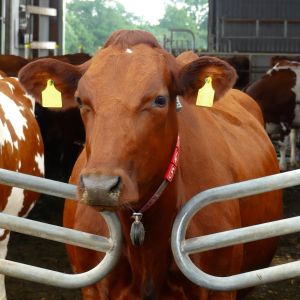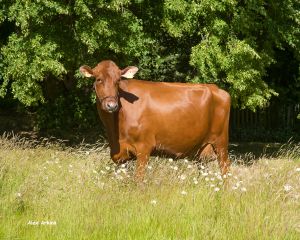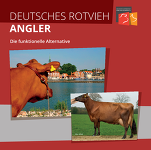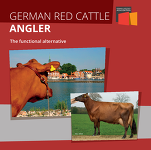Red Cattle / Angler
The Angler cattle has been bred in Schleswig-Holstein for over 140 years and is characterised by its mostly solid red coat colour. In very many countries of the world this breed contributes to the improvement of conformation and production of the native red breeds.
Since 1906, this breed has been under milk recording.
Due to the consumption habits of the German population, the breeding management board today tries to further increase the milk yield significantly while maintaining the protein percentages. In addition to the high milk content, the very good daily gains in fattening animals, the early maturity as well as the easy calving, the excellent legs and black claws as well as the low calf losses are particularly noteworthy for this breed. The economic ratio of feed to milk production and the good grazing ability are the basis of performance reliability and adaptability in all climatic zones.
After many years of using top sires of the Red Holstein breed in the breeding programme, the Anglers are now in a consolidation phase and are attempting to push back the Red Holstein percentage. In addition to proven sires from their own population, Swedish Red bulls (SRB), Red Danes (RDM) as well as Canadian Ayrshire are used in a combined breeding programme in order to maintain the high breeding progress that has been achieved over many years.
Today the German Angler population consists of over 10,000 cows under milk recording in Germany. The breed is still particularly widespread in its homeland Schleswig-Holstein. On average the breed achieves a performance of over 8,200 kg milk per lactation with high contents (4.52 % fat, 374 kg fat, 3.62 % protein, 299 kg protein).
Breeding goal
The goal is an economical, robust performance cow of the milk-emphasising type, which can be used over many lactations due to its large feed intake capacity, stable health and good fertility.
Today's breeding goal of the German Red Cattle is 9,500 kg milk with 4.5 % fat and 3.8 % protein. The adult cows should reach about 145 cm height at the sacrum and a body weight of 650 kg.
The particular strengths of the breed lie above all in the economic ratio of total feed intake to a good milk yield with high protein content. Angler cattle move on excellent feet and legs with firm, typically dark claws. Furthermore, a high resistance to disease and mastitis, vitality, as well as easy calving and low calf losses are aimed for, in addition to a smooth adaptation to all climatic zones. Angler heifers have a good youth development, are of early maturity and calve without problems already at the age of 24 months. Young bulls have good growth rates and reach a live body weight of 400 kg at twelve months. The milk of the Angler cows is particularly suitable for cheese production, because on the one hand the protein content is over 3.6 % and on the other hand the majority of the sires used are carriers of the kappa-casein B gene, which also ensures good cheese-making properties.
The German Red Cattle / Angler is marked red, but can also be red and white by crossing other genes.
Breeding programme
The herdbook cows form the active breeding population from which 50 bull mothers are selected annually for the breeding programme and - in addition to some excellent young cattle - are mated with the best sires for the next bull generation. In addition to proven sires, the Angler breeding programme also uses bull sires from Scandinavia, these are primarily Red Danes (RDM) and Swedish Red (SRB). The Ayrshire breed is used via Finnish and Canadian bloodlines. The use of other European Red cattle breeds allows a high breeding progress and guarantees a wide variance in the genes.
Genomic selection
Since 2016 there has been a genomic breeding value estimation for the Angler breed in cooperation with Viking Genetics and the data centre vit in Verden. This made it possible to replace the test bulls that had been used until then. On the basis of about 8,000 daughter-proven sires and about 12,000 females from Scandinavia and Germany, a robust data reliability is achieved, so that the reliability of the calculated genomic breeding values is about 60%. By identifying negative breeding traits at an early stage, only bull calves are purchased that can bring sustainable breeding progress in economically important traits, especially functionality. For all typed bulls, linear profiles are also available on a genomic basis. Thus, matings for trait improvement can be carried out in a much more targeted way than with bulls selected on the basis of pedigree related breeding values.
For further information on the German Red Cattle / Angler, please visit the RSH website.














